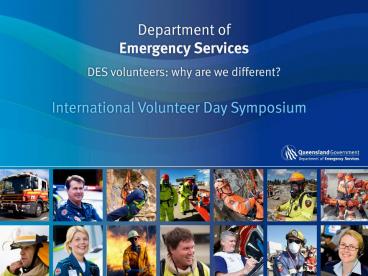DES volunteers' Why are we different - PowerPoint PPT Presentation
1 / 15
Title:
DES volunteers' Why are we different
Description:
Discreet Indigenous Communities (Aboriginal and Torres Strait Islander local ... Establish and introduce Disaster Management Plans for Discreet Indigenous Communities ... – PowerPoint PPT presentation
Number of Views:70
Avg rating:3.0/5.0
Title: DES volunteers' Why are we different
1
(No Transcript)
2
DES volunteers. Why are we different?
- High risk activities
- Extensive training
- Long term commitment
- Impacts of Climate Change
- Demanding more from limited volunteers in
coastal, rural and remote communities which are
vulnerable to natural disasters.
3
A day in the life of DES
- Paramedics provide 2,408 responses
- Fire crews attend 186 incidents
- 57 baby capsules are fitted
- 174 community education certificates are issued
- 45 building fire safety inspections are conducted
- 200 hours of Volunteer SES Operations per day
- 8.6 flight hours for aeromedical, search and
rescue and counter disaster ops
Source 2007- 08 DES Annual Report
4
Rural Fire Service
93 of Qld covered by Rural Fire Service 34 631
volunteers 1506 Rural Fire Brigades RFS supported
by QFRS Rural Operations Respond to fires, RCRs,
natural disasters, intra interstate
deployments, horse flu, cane smut, etc
5
State Emergency Services
152 SES Units 341 SES Groups 6430 volunteers
Flood Operations, Storm Damage Search Operations,
Road Crash Rescue, Vertical Specialist Rescue
Incident Management
6
Recent Storms 23, 124 calls received by SES
hotline between 16/11 22/11 250-400 SES
volunteers working each day to assist
contributing 23,000 hours of work 4043 jobs
completed and 932 tarping jobs since Sunday 16
November
7
QAS Volunteers
Local Ambulance Committees 166 committees 1500
members
Honorary Officers 413 operational volunteers
8
Australian Volunteer Coast Guard 1677 active
volunteers 1957 responses in 2007/08
Volunteer Marine Rescue 1462 active
volunteers 4174 responses in 2007/08
Australian Surf Life Saving 31 976 active
volunteers 238 584 responses in 2007/08 3996
lives saved 2007/08
Royal Life Saving Society Queensland 125 members
35 x Scientific (QFRS)- 90 x ESU members - 288 x
DES cadet adult leaders,
9
Volunteer Diversity
- Discreet Indigenous Communities (Aboriginal and
Torres Strait Islander local government areas)
rely on volunteers for RFS, SES and Community
First Responder volunteers. - Training conducted locally by EMQ, QFRS, QAS
officers. Accredited training developing skills,
knowledge and social inclusion within
communities. - Volunteering in these communities is dependant on
support from the community and local
organisations.
10
Keeping our Mob Safe
Establish and introduce Disaster Management Plans
for Discreet Indigenous Communities Establish
and introduce Local Disaster Management Groups in
those communities Establish volunteer groups
including SES, RFS, Community First Responders
and Emergency Service Units Queensland has had a
significant involvement in the development of
this strategy
11
Increase Inclusion
DES promotes linking communities from diverse
backgrounds into emergency service volunteer
roles. Encompasses Culturally And
Linguistically Diverse (CALD) Discreet
Indigenous Communities
Communities protecting communities with
membership representing those communities.
12
Toward Q2 Tomorrows Queensland
Increase the proportion of Queenslanders who
volunteer in their communities by 50.
13
Social Inclusion of Volunteers
- Development of Volunteer Management Strategy
- Ongoing SES recruitment campaign
- Rural Fire Service Recruitment Kit
- Introduction of new membership categories for RFS
- Emergency Service Volunteer Campaign
- Inclusion of volunteers from diverse backgrounds
- Building partnerships across Government and with
Communities
14
Challenges
- Demand (higher reliance, climate change)
- Attraction, Retention and Recruitment
(competitive environment, episodic issues,
younger volunteers) - Training (commitment, safety, flexible options,
costs) - Funding (ever increasing costs to train, equip,
fit out) - Cyclic economy (will volunteers still volunteer
due to economic status?)
15
Thank You
Queensland Ambulance Service - www.ambulance.qld.g
ov.au Rural Fire Service - www.ruralfire.qld.gov.
au Emergency Management Qld -www.emergency.qld.go
v.au/ses































